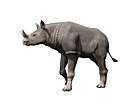
Ancylopoda is a group of browsing, herbivorous, mammals in the Perissodactyla that show long, curved and cleft claws. Morphological evidence indicates the Ancylopoda diverged from the tapirs, rhinoceroses and horses (Euperissodactyla) after the Brontotheria; however, earlier authorities such as Osborn sometimes considered the Ancylopoda to be outside Perissodactyla or, as was popular more recently, to be related to Brontotheriidae.

Perissodactyla is an order of ungulates. The order includes about 17 living species divided into three families: Equidae, Rhinocerotidae (rhinoceroses), and Tapiridae (tapirs). They typically have reduced the weight-bearing toes to three or one of the five original toes, though tapirs retain four toes on their front feet. The nonweight-bearing toes are either present, absent, vestigial, or positioned posteriorly. By contrast, artiodactyls bear most of their weight equally on four or two of the five toes: their third and fourth toes. Another difference between the two is that perissodactyls digest plant cellulose in their intestines, rather than in one or more stomach chambers as artiodactyls, with the exception of Suina, do.

Moropus is an extinct genus of large perissodactyl mammal in the chalicothere family. They were endemic to North America during the Miocene from ~20.4–13.6 Mya, existing for approximately 6.8 million years. Moropus belonged to the schizotheriine subfamily of chalicotheres, and has the best fossil record of any member of this group; numbers of individuals, including complete skeletons, have been found.
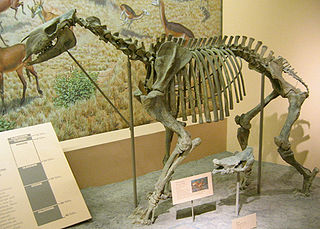
Chalicotherioidea is an extinct superfamily of clawed perissodactyls that lived from the early Eocene to the early Pleistocene subepochs. Based on the fossil record they emerged and thrived largely in Eurasia, although specimens have been found in both Africa and North America. They were likely browsers that fed mainly on leaves, twigs, and other nonresistant vegetation. Many of the contained genera had derived specializations of the forelimb and manus that allowed the claws to be used as hooks for browsing and to be kept off of the ground while walking. Chalicotheres lived primarily in forested areas. Size sexual dimorphism and morphological structures such as the domed skulls of Tylocephalonyx suggest agonistic behaviour in some sort of social setting. They are related to modern day horses, rhinoceroses, and tapirs, as well as the extinct brontotheres.
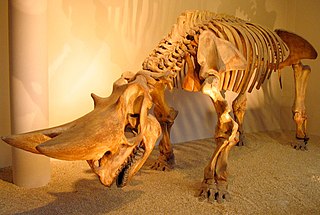
Embrithopoda ("heavy-footed") is an order of extinct mammals known from Asia, Africa and Eastern Europe. Most of the embrithopod genera are known exclusively from jaws and teeth dated from the late Paleocene to the late Eocene; however, the order is best known from its terminal member, the elephantine Arsinoitherium.

Chalicotheriidae is an extinct family of herbivorous, odd-toed ungulate (perissodactyl) mammals that lived in North America, Eurasia, and Africa from the Middle Eocene to the Early Pleistocene. They are often called chalicotheres, a term which is also applied to the broader grouping of Chalicotherioidea. They are noted for their unusual morphology compared to other ungulates, such as their clawed forelimbs. Members of the subfamily Chalicotheriinae developed elongate gorilla-like forelimbs that are thought to have been used to grasp vegetation. They are thought to have been browsers on foliage as well as possibly bark and fruit.
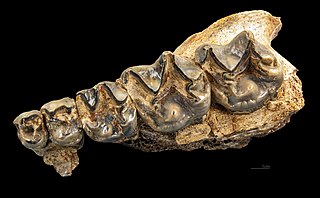
Chalicotherium is a genus of extinct odd-toed ungulates of the order Perissodactyla and family Chalicotheriidae. The genus is known from Europe and Asia, from the Middle Miocene to Late Miocene.

Ancylotherium is an extinct genus of the family Chalicotheriidae, subfamily Schizotheriinae, endemic to Europe, Asia, and Africa during the Late Miocene-Early Pleistocene, existing for approximately 9.8 million years.

The John Day Formation is a series of rock strata exposed in the Picture Gorge district of the John Day River basin and elsewhere in north-central Oregon in the United States. The Picture Gorge exposure lies east of the Blue Mountain uplift, which cuts southwest–northeast through the Horse Heaven mining district northeast of Madras. Aside from the Picture Gorge district, which defines the type, the formation is visible on the surface in two other areas: another exposure is in the Warm Springs district west of the uplift, between it and the Cascade Range, and the third is along the south side of the Ochoco Mountains. All three exposures, consisting mainly of tuffaceous sediments and pyroclastic rock rich in silica, lie unconformably between the older rocks of the Clarno Formation below and Columbia River basalts above.

Tylocephalonyx is an extinct chalicothere from the Miocene of North America.

Borissiakia is an extinct genus of chalicothere, a group of herbivorous, odd-toed ungulate (perissodactyl) mammals, that lived during the late Oligocene in Kazakhstan. They had claws that were likely used in a hook-like manner to pull down branches, suggesting they lived as bipedal browsers.

Nestoritherium is an extinct genus of chalicothere; it has been dated to have lived from the late Miocene to the Early Pleistocene. This range makes Nestoritherium one of the most recently dated chalicotheres. It has been found in fossil sites in Myanmar and China.

Schizotherium is an extinct genus of schizotheriine chalicothere known from the Oligocene of Europe and Asia.

Schizotheriines are one of the two subfamilies of the extinct family Chalicotheriidae, a group of herbivorous odd-toed ungulate (perissodactyl) mammals that lived from the Eocene to the Pleistocene. The other clade is the Chalicotheriinae. Both clades had claws rather than hooves on their front feet, an adaptation understood as related to feeding. Schizotheriines also had claws on their hind feet. The fossils of both groups are found in environments that had trees and shrubs. While chalicotheriines developed very derived body forms, schizotheriines remained basically similar in shape to other perissodactyls such as horses and tapirs. Like most forest-dwelling ungulates, they had long necks and forelimbs longer than their hindlimbs. Schizotheriines had longer, higher-crowned cheek teeth than chalicotheriines, which indicates they typically fed on tougher vegetation. The sediments where their fossils are found show they also lived in a wider range of environments, from moist forests to drier woodland or savannah-like environments with trees. Perhaps for this reason, they became more widely distributed than chalicotheriines. Though chalicotheres likely evolved in Asia, schizotheriine fossils are also found in Africa and North America, which they reached by the Bering land bridge. The best-known schizotheriine genus is Moropus. The last survivor of the group was traditionally thought to be Nestoritherium, but it was found to actually be a member of Chalicotheriinae.
Metaschizotherium is an extinct genus that belongs to the family Chalicotheriidae, which was a group of herbivorous perissodactyl ("odd-toed") mammals. Though found primarily in Europe, fragmentary remains suggest that their range extended into Asia.

Chalicotheriines are one of the two subfamilies of the extinct family Chalicotheriidae, a group of herbivorous, odd-toed ungulate (perissodactyl) mammals that lived from the Eocene to the Pleistocene. The other subfamily is the Schizotheriinae. Chalcotheriines evolved unique characteristics for ungulates, with very long forelimbs, short hindlimbs, and a relatively gorilla-like physique, including knuckle-walking on their flexible forelimbs, which bore long curved claws. Members of this subfamily possessed some of the longest forelimbs and shortest hindlimbs in relation to each other out of all extinct animals. Analysis of dental wear implies that most chalicotheriines fed on seeds and fruit. Their claws were likely used in a hook-like manner to pull down branches, suggesting they lived as bipedal browsers.

Phenacodontidae is an extinct family of large herbivorous mammals traditionally placed in the “wastebasket taxon”Lophocion asiaticus.
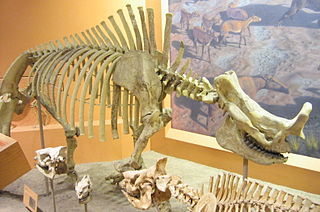
Brontotheriidae is a family of extinct mammals belonging to the order Perissodactyla, the order that includes horses, rhinoceroses, and tapirs. Superficially, they looked rather like rhinos with some developing bony nose horns, and were some of the earliest mammals to have evolved large body sizes of several tonnes. They lived around 56–34 million years ago, until the very close of the Eocene. Brontotheres had a Holarctic distribution, with the exception of Western Europe: they occupied North America, Asia, and Eastern Europe. They were the first fossilized mammals to be discovered west of the Mississippi, and were first discovered in South Dakota.

Altungulata or Pantomesaxonia is an invalid clade (mirorder) of ungulate mammals comprising the perissodactyls, hyracoids, and tethytheres.

Systemodon is a genus of early Eocene mammal of Wasatchian age. It was one of many mammals originally considered the earliest horses, long classified in the genus Hyracotherium. These were dog-sized animals that in life would have looked vaguely like a paca, mara, or chevrotain The type species, S. tapirinus, is represented by 24 individuals from a locale called the Castillo pocket in the Huerfano Formation of Colorado. This well-preserved deposit allows researchers to reconstruct aspects of the environment and lifestyle of the species.

























